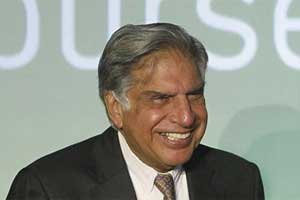 Washington, Oct 7: Leading industrialist Ratan Tata has been inducted into the prestigious National Academy of Engineering (NAE) in the US for his outstanding contributions to industrial development in India and across the world.
Washington, Oct 7: Leading industrialist Ratan Tata has been inducted into the prestigious National Academy of Engineering (NAE) in the US for his outstanding contributions to industrial development in India and across the world.
Besides Tata, eight Indian-Americans have been inducted into the institute, considered among the highest professional distinctions accorded to an engineer.
Tata, the 75-year-old chairman emeritus of the Tata Group, has been inducted as a Foreign Associate.
Founded in 1964, the National Academy of Engineering (NAE) is a private, independent, nonprofit institution that provides engineering leadership in service to the nation.
The NAE this year has elected 69 new members and 11 foreign associates, thus bringing the total US membership to 2,250 and the number of foreign associates to 211.
Anant Agarwal, president, edX (online learning initiative of MIT and Harvard University) and professor electrical engineering and computer science department in Massachusetts Institute of Technology has been elected for his contributions to shared-memory and multicore computer architectures.
Murty P Bhavaraju senior consultant, has been elected for probabilistic reliability evaluation tools for large electric power systems; and Ashok Gadgil, director and senior scientist, environmental energy technologies division, Lawrence Berkeley National Laboratory, for engineering solutions to the problems of potable water and energy in underdeveloped nations.
Other Indian-Americans inducted into the Academy are Ganesh Kailasam, from Dow Chemical, Vijay Kumar, from University of Pennsylvania, Bal Raj Sehgal, emeritus professor of nuclear power safety, Royal Institute of Technology, Stockholm, Pradeep S Sindhu, founder, Juniper Networks and Krishna P Singh, president and chief executive officer, Holtec International.
C D Mote, President of the NAE, addressing the annual meeting of the institute yesterday, said recruitment of talented international students over the past half century has contributed remarkably to US engineering.
With respect to the number of engineering graduates, according to a 2012 National Science Board report, the percentage of undergraduate engineering degrees among all undergraduate degrees in the US was 4 per cent, among the smallest national percentages in the world, he said.
"For a sense of scale, the average percentage in key Asian countries (India, Japan, China, Taiwan, South Korea, and Singapore) is 23 per cent, and in European countries (UK, Sweden, Finland, Denmark, Germany, and France) it's 13 per cent. In short, the percentage of US engineering graduates among all its graduates is 1/3 of the European average and 1/6 of the Asian competitor average," he said.
"We now have bilateral Frontiers programs with Germany, Japan, China, India, and the EU, and a new one with Brazil is scheduled for 2014."






Comments
Add new comment